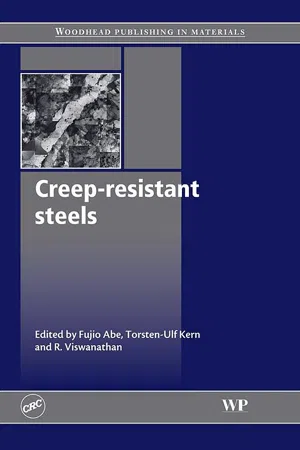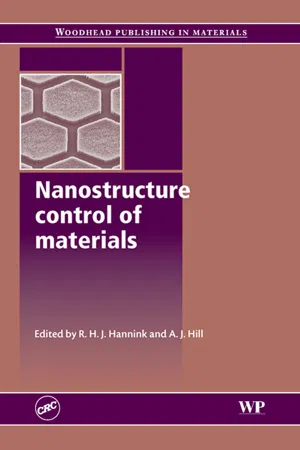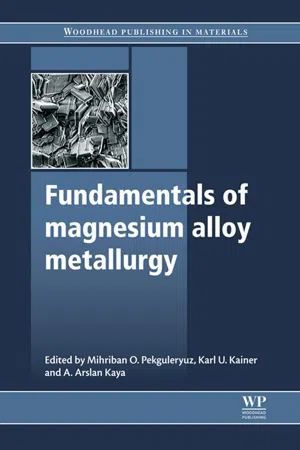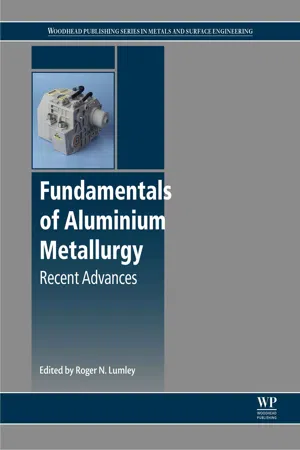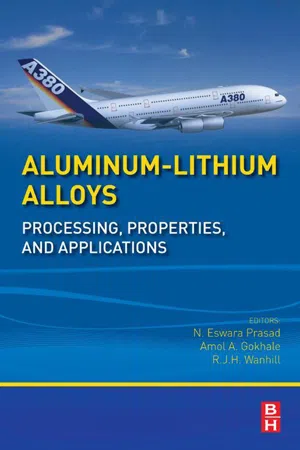Technology & Engineering
Precipitation Hardening
Precipitation hardening is a heat treatment process used to strengthen certain types of metals and alloys, such as aluminum and stainless steel. It involves heating the material to a high temperature, then rapidly cooling it to form a supersaturated solid solution. Subsequent aging at a lower temperature causes the formation of fine particles within the material, increasing its strength and hardness.
Written by Perlego with AI-assistance
Related key terms
Related key terms
1 of 4
Related key terms
1 of 3
7 Key excerpts on "Precipitation Hardening"
- eBook - ePub
- Fujio Abe, Torsten-Ulf Kern, R Viswanathan(Authors)
- 2008(Publication Date)
- Woodhead Publishing(Publisher)
10Precipitation during heat treatment and service: characterization, simulation and strength contribution
E. Kozeschnik; I. Holzer Graz University of Technology, Austria10.1 Introduction
Precipitation Hardening is one of the most prominent ways of strengthening materials. Precipitates can effectively hinder dislocation and subgrain movement and thus increase the resistance of the material microstructure against plastic deformation. In industrial processes, size and number density of precipitates are controlled by the chemical composition of the alloy as well as the thermomechanical processing route. Owing to the significant influence of precipitates on the mechanical properties of the material, efficient characterization, modelling and simulation of precipitation processes in multi-component alloys are of considerable relevance for industry as well as for academics. The goal of these activities is to be able to produce materials with an optimized spectrum of mechanical properties based on a fundamental understanding of the complex interactions between precipitates and microstructure.Materials with superior creep properties are characterized by a microstructure, which exhibits a superior long-term resistance against plastic deformation. This can be achieved by strong pinning forces upon dislocations and subgrain boundaries. The two major effects of precipitates on the creep properties of a material are:•Increase of the creep strength by direct interaction between precipitates and dislocations. Precipitates effectively hinder dislocations in their ability to move through the material as a consequence of an external load. Thus, the creep process is considerably slowed down and the creep rate is minimized.•Stabilization of the initial microstructure by pinning of grain and sub-grain boundaries. The high strength of the materials in the as-received condition, i.e. the conditions in the delivery state before service, is conserved, because grain and sub-grain coarsening is minimized. - Samsul Ariffin Abdul Karim(Author)
- 2022(Publication Date)
- CRC Press(Publisher)
Bishop & Smallman, 1999 ).Changes in the properties of the quenched material after aging are more pronounced. In particular, the mechanical properties undergo major modifications. For example, the tensile strength of duralumin (an aluminum alloy – 4% copper containing magnesium silicon and manganese) can be increased from 0.21 to 0.41 GN/m2 . Structural sensitive properties such as hardness, yield stress, and so on, of course, depend on the distribution of the phase structure; thus, such alloys experience softening when the finely dispersed precipitate hardens (Bishop & Smallman, 1999 ). The process of Precipitation Hardening or hardening can be divided into several stages (Callister & Rethwisch, 2015 ) as follows:- Solution heat treatment, which is heating the alloy above the solvus line.
- Rapid cooling (quenching).
- Precipitation heat treatment (aging), where the workpiece is heated to a temperature of T2, where the supersaturated solid solution begins to form the phase. This phase appears in the form of a fine precipitate which is dispersed and increases the strength of the metal. The heating duration depends on the formation stage of the optimum solidifying sediment.
There are several types of precipitation heat treatment (Callister & Rethwisch, 2015 ), which are as follows:- Natural Aging
In the natural aging process, the alloy does not experience heating. Only left at room temperature, in this process, it takes a long time, and the strengthening effect given is not so great. The precipitates in the matrix are still random (Triantafyllidis et al., 2015 ).- Artificial Aging
Artificial aging is a process where the alloy is heated to a certain temperature. At this stage, the precipitates are evenly distributed and form groups; at this stage the optimum strengthening effect can be produced (Abo Zeid, 2019- eBook - ePub
- R H J Hannink, A J Hill(Authors)
- 2006(Publication Date)
- Woodhead Publishing(Publisher)
2 B).Subsequent investigations showed that the complete process of age or Precipitation Hardening may involve several stages commencing with the formation of fine, coherent zones that were first detected in 1938 by X-ray diffraction techniques.Historically, special attention has been paid to studying the mechanisms of Precipitation Hardening in the Al-Cu system in which the complete precipitation sequence has been identified as:12 ,13However, it was not until the development of transmission electron microscopy in 1956 that much of the fine detail associated with Precipitation Hardening was revealed. Precipitation Hardening became recognised as the most common method for strengthening by heat treatment and has also been applied to alloys based on other metals including copper, titanium, nickel, magnesium and lead. The major challenge in using age hardening for strengthening of alloys is to promote the formation of precipitates that are large enough to resist being sheared by dislocations, yet are too finely spaced to be by-passed. This critical condition is often difficult to produce in practical alloys, but a near approximation is often able to be achieved.S . S . S . S → GP zones →→θ ′′θ ′→ θ .GP (Guinier–Preston) zones are ordered, solute-rich clusters of atoms that are coherent with the parent lattice and are of only one or two atomic planes in thickness. They may be present in densities as high as 1018 /cm3 . Although they are readily sheared by moving dislocations, they are still able to cause significant strengthening because of the strain they impart into the surrounding lattice. The phase θ“ is also coherent with the aluminium lattice, and can be regarded as a higher order zone. The intermediate phase θ’ is semi-coherent and occurs as plates that are typically much larger than the θ”. The equilibrium precipitate θ (Al2 Cu) is incoherent with the aluminium lattice and, because it is normally coarsely dispersed, causes little strengthening. In this condition an alloy is termed overaged. The hardness–time curve for an Al-4Cu alloy aged at 150 °C is shown in Fig. 9.3(a) . The microstructure of the alloy at the peak aged condition in shown in Fig. 9.3(b) - eBook - ePub
- Mihriban O Pekguleryuz, Karl Kainer, A. Arslan Kaya(Authors)
- 2013(Publication Date)
- Woodhead Publishing(Publisher)
4Understanding precipitation processes in magnesium alloys
C.L. Mendis, Helmholtz Zentrum Geesthacht, Germany (formerly of National Institute for Materials Science, Japan)K. Hono, National Institute for Materials Science, JapanAbstract:
Recent interest in developing high strength wrought magnesium alloys has revived studies of precipitation processes in magnesium alloys, as they can be used to control recrystallized microstructure and to add yield strength by age hardening after processing of wrought magnesium. In this chapter, we describe the basic information necessary for controlling precipitate microstructures by aging. Thereafter, precipitation processes and microalloying effects in representative age-hardenable magnesium alloys are reviewed.Key words precipitation solid state phase transformations age hardening4.1 Introduction
Magnesium alloys have attracted renewed interest as light alloys, to substitute some conventional structural materials for weight reduction in vehicles such as cars, trucks, trains and aircrafts. Cast alloys, widely used in interior and power-train components, account for more than 99% of magnesium alloys used today, while only a small number of wrought products are utilized. This is because magnesium alloys lack formability for wrought applications, and their high cost discourages the use of magnesium alloys for automotive applications.Rare earth (RE) elements, such as CeGd, Nd and Y, are often used as major alloying elements in cast magnesium alloys because of their relatively high solubility in Mg and their effectiveness in Precipitation Hardening and creep resistance. In fact, several Mg–RE alloys show a notable age hardening response, which can lead to substantial strengthening in Mg (Khoarashahi, 1997 ; Nie and Muddle, 2000 ;Lorimer et al., - eBook - ePub
- Sir Alan Cottrell(Author)
- 2019(Publication Date)
- CRC Press(Publisher)
All the plastic deformation tends to concentrate there and produce cracks at the triple junctions (cf. § 21.12). Several techniques have been developed to prevent the formation of these precipitate-free regions near grain boundaries, including interruption of cooling during the quench (step-quenching). Plastic deformation is sometimes helpful in promoting nuclei for precipitation in the regions. Trace amounts of certain substances may also be added to modify the precipitation process (see § 20.3). The final stage in the sequence of changes, as the quenched alloy is heated at successively higher temperatures, is coarsening, in which the particles of equilibrium precipitate become larger and fewer. This is due to competitive growth, driven along by the large interfacial energies of these incoherent particles. The smaller of these particles have higher free energies per atom than the larger ones, because of their higher ratios of surface to volume (cf. eqn. 12.32). The concentration of solute in the matrix is thus higher near the small particles than the large ones. This sets up a diffusion flow, from the small particles which thereby dissolve and disappear, to the large ones which thereby grow still larger. 20.3 Development of commercial age-hardening alloys For high strength, an age-hardened alloy should contain a large volume fraction (≫0.01) of fine particles (10–100 Å) distributed uniformly without precipitate-free regions. The most direct way to obtain a large volume fraction is to have a high solubility at high temperatures which falls to a very low value at the ageing temperature, as in the successful Cu-Be and Ni-(Ti, Al) alloys. Another approach is to develop complex alloys, containing several solutes which may precipitate independently or in combination. Thus magnesium and silicon may be added to aluminium to form zones and intermediate precipitates leading towards the very stable Mg 2 Si compound - eBook - ePub
Fundamentals of Aluminium Metallurgy
Recent Advances
- Roger Lumley(Author)
- 2018(Publication Date)
- Woodhead Publishing(Publisher)
Fig. 10.13 Schematic illustration showing the temporal evolution of (high-strength) 6000 series alloy hardening during natural (left side ) and artificial (right side ) ageing to around peak strength. The red line indicates an alloy that is quenched, naturally aged, and artificially aged; the blue line indicates an alloy that is quenched and immediately artificially aged. The dotted and solid lines represent the variations in behaviour due to compositional and heat treatment parameters. Approximate ageing times are indicated, but not drawn to scale.10.4.1.6 Design Strategies to Minimize the Influence of Prior NA
10.4.1.6.1 Thermal Processing
Keeping the above discussion in mind, it is possible to design alloys and heat treatments to minimize the negative influence of NA when room temperature storage is unavoidable. The most common and industrially established technique, which is known as preageing (PA), is an intermediate temperature ‘stabilization’ heat treatment (usually around 100°C), performed immediately after solutionization quench, and often allowed to slow cool back down to room temperature [34] . Preageing before room temperature storage aids in maintaining a relatively soft condition (T4P) and is known to reduce the negative influence of NA (although typically not eliminate it, as compared to the directly aged condition) [137 –141 ]. Compared to RT natural ageing, intermediate temperature preageing below 100°C is still too low to allow precipitation, but induces the formation of larger clusters/zones with a more consistent and balanced solute composition (as determined by APT) [124 ,132 ,142 ,143] . These preaged clusters reduce the degree of subsequent NA clustering/instability, and are typically thought to act as nuclei which transform into strengthening precipitates during later AA (or alternatively act as heterogeneous nucleation sites for strengthening precipitates). Similar effects can be created by modifying the cooling/quenching process after solution treatment. For example, interrupted or two-stage quenching, involving an isothermal hold at temperatures below that of AA has been shown to reduce the negative impact of long term NA on Precipitation Hardening [144] . Additionally, slow cooling after solutionization reduces the negative effect, but at the expense of overall solute and vacancy supersaturation [112 ,145 –147 - eBook - ePub
Aluminum-Lithium Alloys
Processing, Properties, and Applications
- N Eswara Prasad, Amol Gokhale, R.J.H Wanhill(Authors)
- 2013(Publication Date)
- Butterworth-Heinemann(Publisher)
* Defence Metallurgical Research Laboratory, Hyderabad-500 058, India,† Regional Centre for Military Airworthiness (Material), CEMILAC, Hyderabad-500 058, IndiaThis chapter reviews the precipitation and precipitate phases that occur during heat treatments in multi-component Al-Li based alloys. It describes aspects related to nucleation, growth, morphology and orientation relationships of the strengthening precipitates δ’ and T1 , the toughening precipitate S’ and the recrystallisation-inhibiting precipitate β’. Equilibrium precipitate phases such as T2 , which are deleterious to the mechanical and corrosion properties of the alloys, are also described. It is shown that careful alloy chemistry control, two-step homogenization and controlled stretching prior to ageing can be employed to improve the volume fraction and distribution of the precipitate phases. All these processing aspects are necessary to achieve optimum combinations of properties for the alloys.ContentsKeywords
Al-Li alloys; homogenization; solution treatment; ageing; δ’; T1 ; S’; T24.1 Introduction 4.2 Microstructures in the Solution-Treated Condition 4.2.1 Alloys with Zr 4.3 Age Hardening Behavior 4.3.1 Age Hardening Curve 4.3.2 Microstructures at Different Stages of Aging 4.3.3 Microstructures After High-Temperature Exposure 4.4 Characteristics of Precipitates4.4.1 Al3 Li (δ ′) Phase4.4.2 Al2 Cu (θ ′) Phase4.4.3 Al2 CuLi (T1 ) Phase in Ternary Al–Li–Cu Alloys4.4.4 Al2 CuLi (T1 ) Phase in Quaternary Al–Li–Cu–Mg Alloys4.4.5 Al2 CuMg (S′) Phase and the Equilibrium S Phase4.4.6 Al3 Zr (β ′) Phase4.4.7 AlLi (δ ) Phase4.4.8 Al6 CuLi3 (T2
Index pages curate the most relevant extracts from our library of academic textbooks. They’ve been created using an in-house natural language model (NLM), each adding context and meaning to key research topics.
Explore more topic indexes
Explore more topic indexes
1 of 6
Explore more topic indexes
1 of 4
